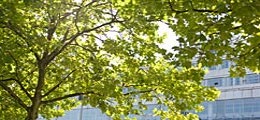CeBiTec Colloquium
| date | Monday, October 18th 2010, 17 c.t. | |
| location | G2-104, CeBiTec Building | |
| speaker | Dr. Mari-Anne NewmanFaculty of Life Sciences, Department of Plant Biology & Biotechnology, University of Copenhagen, Denmark | |
| title | Bacterial Microbe Associated Molecular Patterns (MAMPs): Elicitors of Plant Innate Immunity | |
| In my laboratory we have chemically examined LPS (lipopolysaccharides) and PGN (peptidoglycan) from two Gram-negative plant pathogens, Xanthomonas campestris pv. campestris (Xcc) and Agrobacterium tumefaciens (At) and looked at their effects in plants. In the case of PGN we show that PGN functions as a Microbe Associated Molecular Pattern (MAMP) in plants by triggering diverse innate immune responses, and that its perception is dose dependent. Clear differences in the structures of Xcc and At PGNs and their constituent muropeptides were found and may explain why Xcc PGN was a better elicitor of plant immune responses than At PGN; the lower efficacy of At PGN might relate with its subtle, biotrophic mode of invasion. However, for both bacteria the muropeptides were more effective in triggering immune responses in Arabidopsis than the native PGN. These findings demonstrate for the first time that PGN from true plant pathogenic bacteria functions as a MAMP. We have investigated the role of LPS in plant innate immunity for a number of years. I will present new data to show that Arabidopsis PEN1, a SNARE protein believed to be required for docking and fusion of intracellular transport vesicles is involved in signal transduction leading to the induction of the innate immune responses by particular bacterial MAMPs. Specifically we show that PEN1 is required for induction of PR1 gene induction, callose deposition and generation of reactive oxygen species by LPS but not by flagellin (Flg). These findings, which suggest multiple roles for PEN1 in determining plant resistance to pathogens, will be discussed in the light of previously published work that shows internalisation of LPS on application to suspension cultured cells and the recent work implicating PEN1 in resistance to fungal pathogens. Finally I will describe effects of MAMP combinations and their interactions with the host cell wall. | ||
| host | Prof. Dr. Karsten Niehaus |



